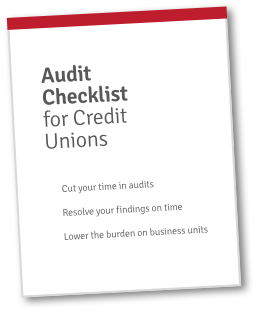How to Measure Success when Implementing Auditing Solutions
Finding a solution to address credit union auditing inefficiency is difficult enough. Measuring success after actually implementing changes in the audit process is an additional challenge.
Specifically, it’s difficult to know how to measure the efficacy of the solution. How can auditors know that the impact is significant enough? What is the benchmark of success?
This is even more challenging when you try to use a metric that means something for non-audit members of the credit union. For example, those in leadership positions or on the board might not understand whether your solution works.
In this blog, we’ll introduce a scoring system to simplify the process.
The Universal Metric for Measuring Success
Redboard’s Audit Efficiency Matrix offers an answer to all of these problems by helping auditors understand what criteria to measure. It also shows how to communicate it to the rest of the credit union’s staff and board in a way that makes sense to them.
Of the data points that could be analyzed to estimate the efficacy of an implemented tool or strategy, dollars are the most important. Everyone in the organization understands the value of a dollar. Dollar amounts demonstrate whether the solution they’re using is working—and if it justifies the cost.
The Formulas for Determining a Solution’s Efficacy
Through our work with credit unions and auditors, we’ve developed two simple equations to determine whether or not your tool is effective.
Used together, these equations will demonstrate two things. First, they’ll show how much you’re saving. Second, they’ll show you whether those savings justify the continued use of the solution.
1. Annual Value of Time Savings
The Annual Value of Time Savings assigns a dollar value to the gained efficiency. This figure is easily understandable and can be presented to other members of the organization.
To calculate this figure, divide the time saved per person each week by 40, multiply it by staff salary (meaning all who would be involved in the auditing process without this solution), and multiply that number by 1.3 to get your final dollar figure.
Why 1.3?
The 1.3 multiplier represents the “benefits load” and takes into consideration things like paid vacation, taxes, retirement benefits, and other compensation benefits that credit unions offer their employees.
2. ROI Multiple
The ROI Multiple will use the final figure from the Annual Value of Time Savings to determine exactly how effective your solution is—and whether to continue using it.
To calculate the ROI Multiple, divide the Annual Value of Time Savings by the annual cost of the solution. This number will give you an idea of whether the solution has a meaningful impact to your efficiency.
How to Judge Your Score:
Depending on the tool or strategy, and depending on how your credit union is using it, you may get a range of numbers. One credit union may get a completely different number than another when measuring the same tool or strategy.
Typically, scores range from less than 1 to more than 3. Here’s what scores within that range can tell you about the value and efficacy of the tool or strategy you’re using.
The number is less than 1. A number less than 1 indicates that the tool isn’t offering value at all; in fact, it’s costing more than it’s saving.
The number is between 1–3. If your final figure is between 1 and 3, it’s only marginally helpful. You’re better off trying a different approach that will yield higher efficiency gains.
The number is over 3. If your calculations yield a number greater than 3, your solution is offering significant gains and is actively making the department or organization more efficient.
You may need to adjust your course of action depending on your efficiency goals. Consult the Audit Efficiency Matrix to revisit the types of tools available to help you meet the auditing needs of your organization.
Learn more about it by watching here:


 Get FREE Access to the Audit Checklist for Credit Unions!
Get FREE Access to the Audit Checklist for Credit Unions!


